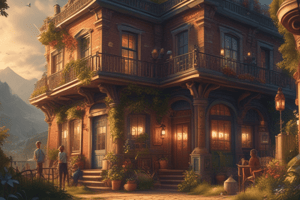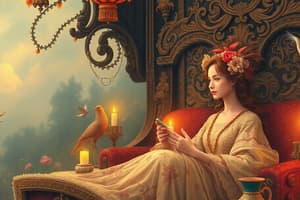Podcast
Questions and Answers
What aspect of a story involves the arrangements of key events that drive the narrative forward?
What aspect of a story involves the arrangements of key events that drive the narrative forward?
- Conflict
- Characters
- Setting
- Plot (correct)
Which of the following best describes the significance of setting in a story?
Which of the following best describes the significance of setting in a story?
- The final outcome of the main conflict
- The physical and emotional environment where the story occurs (correct)
- The sequence of events that escalate the conflict
- The motivation behind characters' actions
What type of conflict occurs between a character and external forces such as society, nature, or other characters?
What type of conflict occurs between a character and external forces such as society, nature, or other characters?
- Internal conflict
- Character conflict
- Interpersonal conflict
- External conflict (correct)
In a narrative, what does resolution refer to?
In a narrative, what does resolution refer to?
Which element of a story describes the individuals who shape the plot and experience the conflict?
Which element of a story describes the individuals who shape the plot and experience the conflict?
What describes the main characters in a story?
What describes the main characters in a story?
How does the setting influence the narrative?
How does the setting influence the narrative?
What type of conflict involves struggles within a character's mind?
What type of conflict involves struggles within a character's mind?
What is the main focus of the resolution in a story?
What is the main focus of the resolution in a story?
Which of these options best describes plot in a narrative?
Which of these options best describes plot in a narrative?
Flashcards are hidden until you start studying
Study Notes
Characters
- Main characters drive the narrative and have significant development throughout the story.
- Supporting characters enhance the story by providing background, contrast, or assistance to main characters.
Setting
- The location can influence the plot and character development, shaping the story's backdrop.
- Time period establishes the historical or cultural context, affecting dialogue, behavior, and technological references.
- Mood contributes to the emotional atmosphere, impacting how scenes are perceived by the audience.
Plot
- Key events are central moments that propel the narrative forward and engage the reader.
- These events often include the exposition, rising action, climax, falling action, and resolution, forming a cohesive structure.
Conflict
- The main conflict serves as the driving force of the story, creating tension and challenges for characters.
- Conflicts can be classified as internal (within a character) or external (between characters or against outside forces).
Resolution
- The main conflict is resolved through various means, including character growth, actions taken, or external circumstances.
- The resolution often leads to a sense of closure or further questions for characters, reflecting the themes of the story.
Characters
- Main characters drive the narrative and have significant development throughout the story.
- Supporting characters enhance the story by providing background, contrast, or assistance to main characters.
Setting
- The location can influence the plot and character development, shaping the story's backdrop.
- Time period establishes the historical or cultural context, affecting dialogue, behavior, and technological references.
- Mood contributes to the emotional atmosphere, impacting how scenes are perceived by the audience.
Plot
- Key events are central moments that propel the narrative forward and engage the reader.
- These events often include the exposition, rising action, climax, falling action, and resolution, forming a cohesive structure.
Conflict
- The main conflict serves as the driving force of the story, creating tension and challenges for characters.
- Conflicts can be classified as internal (within a character) or external (between characters or against outside forces).
Resolution
- The main conflict is resolved through various means, including character growth, actions taken, or external circumstances.
- The resolution often leads to a sense of closure or further questions for characters, reflecting the themes of the story.
Studying That Suits You
Use AI to generate personalized quizzes and flashcards to suit your learning preferences.




